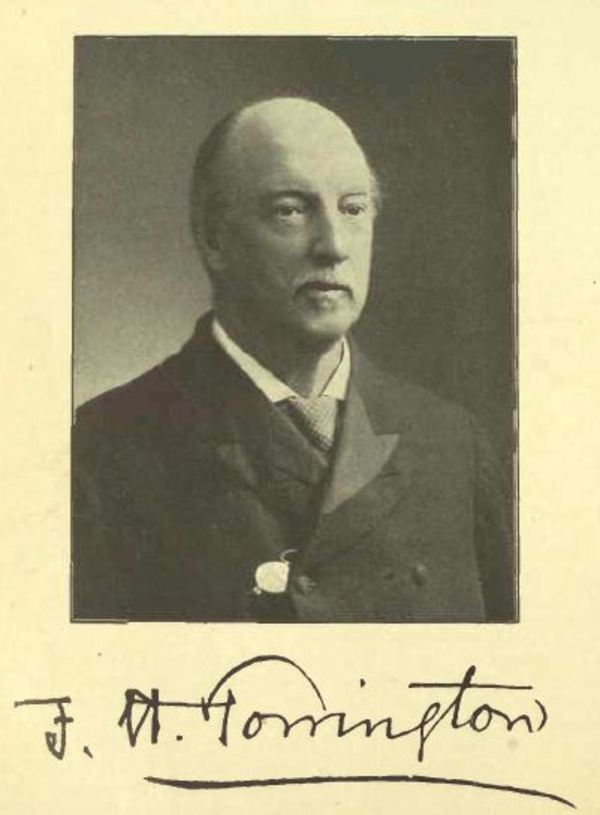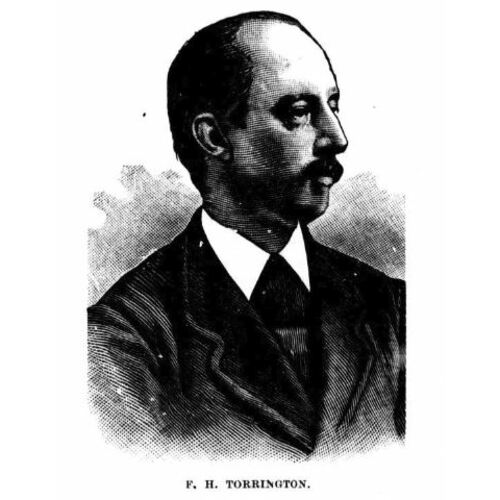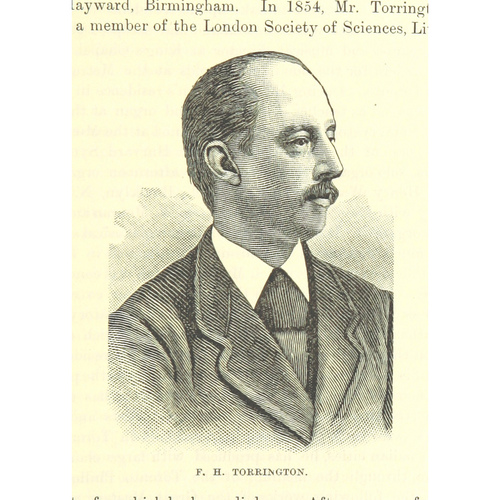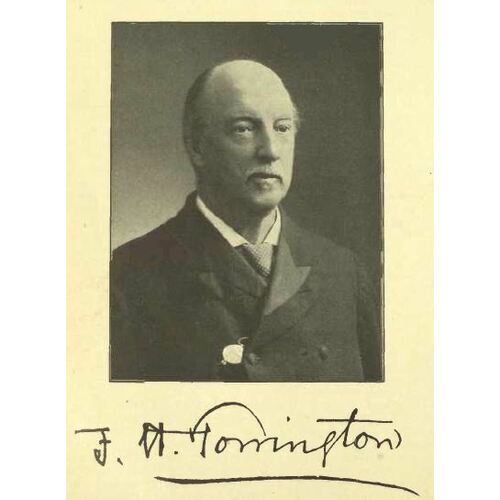
Source: Link
TORRINGTON, FREDERICK (Frederic) HERBERT, musician; b. 20 Oct. 1836 in Dudley, England, son of James Torrington and Jane —; m. 30 Dec. 1856 (when he was reported to be a widower) Mary Thomas (d. 1876) in Old Swinford, England, and they had six daughters and two sons; m. again 5 March 1878 Rosaline Rebecca Kennedy (d. 1941) in Toronto, and they had two sons; d. there 20 Nov. 1917.
Frederick Herbert Torrington began studying the violin in Dudley in 1844 and the piano a year later. In 1852, in Birmingham, he continued on both instruments with Henry Hayward, and he soon added organ and choral training with James Fitzgerald. His first professional appointment was as a church organist and choir master in Bewdley.
Torrington emigrated to Montreal after his marriage to Mary Thomas and became organist and choir master of Great St James Street Methodist Church in 1857. He was active in the city as a conductor and violinist, and he participated in the festival given in honour of the Prince of Wales during his visit in 1860. Torrington also served as organist at Le Gesù for Sunday night services, and for three years he acted as bandmaster of the 25th Foot.
An organ recitalist, Torrington played at the Boston Music Hall on 23 Sept. 1868. The following June he was again in Boston, at the head of the Canadian contingent participating in Patrick Sarsfield Gilmore’s mammoth National Peace Jubilee. The two events no doubt led to his departure from Montreal in September 1869 to become the organist at King’s Chapel in Boston. In 1870 he was a violinist in the orchestra of the Harvard Musical Association under the direction of Carl Zerrahn, and in September of that year he gave an organ recital at the New England Conservatory of Music, of which he was a faculty member from at least 1871. As a recitalist, he performed in 1871 at the celebrated organ concerts at Henry Ward Beecher’s Plymouth Church in Brooklyn (New York City), and two years later he gave two concerts in Hamilton, Ont. Here he met a delegation from Metropolitan Methodist Church in Toronto which offered him the position of organist and choir master. After at first declining for monetary reasons, Torrington accepted and moved to Toronto in the fall of 1873.
Metropolitan Church, built the previous year, offered one of the country’s most prestigious ecclesiastical musical posts. Furthermore, with the retirement in 1873 of James Paton Clarke*, the Toronto Philharmonic Society was looking for a conductor, and Torrington assumed its direction. Over the next 40 years with the society and its successor in 1894, the Festival Chorus, he presented new compositions as well as all the great popular oratorios, including works by Handel, Haydn, Mendelssohn, Dvořák, Weber, Sullivan, Bruch, and Gounod, many of them in their Canadian première. Torrington also established himself outside Toronto as musical director of the Ontario Ladies’ College in Whitby from 1874 to 1881, and as conductor of the Hamilton Choral Society from 1883 to 1887. He applied his organizational skills to the presentation of grand festivals modelled on the gala performances with which he had been associated in Montreal and particularly in Boston. In 1886 he arranged the Toronto Music Festival, held at the rink on Mutual Street, where he led a chorus of 1,000 voices and an orchestra of 100 instrumentalists. The next year he directed a smaller festival in Hamilton in honour of Queen Victoria’s golden jubilee using a chorus of 500 and an orchestra of 60, a considerable undertaking in a small city. That his Toronto festival had had to take place in a rink was a factor in Hart Almerrin Massey*’s decision to build a large concert hall; fittingly, in June 1894 Torrington directed the festival that opened Massey Music Hall. In 1903 he conducted one of the Toronto concerts in the cycle of music festivals organized by Charles Albert Edwin Harriss* which composer Sir Alexander Campbell Mackenzie held in 15 cities across Canada.
Torrington had established the Toronto College of Music in 1888, two years after Edward Fisher began the Toronto Conservatory of Music. When the college opened its doors it boasted some of the best musicians in Canada on its faculty, among them Clarence Reynolds Lucas, Wesley Octavius Forsyth*, Augustus Stephen Vogt*, Herbert Lincoln Clarke, and William Elliott Haslam. In 1890 the college was incorporated, with George Gooderham* as president, and it affiliated with the University of Toronto in order to prepare candidates for the university’s music degrees. Torrington had a wide influence on the standards of musical instruction as a result of the college’s examination system, which he eventually extended from Quebec to British Columbia. In addition, he tried to develop an orchestra through the Toronto Orchestral School, an off-shoot of the college; although some public concerts were given, beginning in June 1892, the venture had only limited success and did not lead to the establishment of a permanent ensemble. His wife, Rosaline Rebecca Kennedy, who had come to Canada in 1869, was the effective manager of the college. She was also active in many organizations, among them the Young Women’s Christian Association, the Girl Guide movement (she was a charter-member in 1912 of the Canadian council), Women’s College Hospital in Toronto, and the National Council of Women of Canada (of which she was president from 1911 to 1918).
Torrington’s long association with Metropolitan Church ended acrimoniously in 1907 when its trustees sought his retirement because of advancing years. He then served as organist at High Park Methodist Church until 1915. He gave organ recitals as late as 1908, when he played in Vancouver, and his last performance with the Festival Chorus was in 1912. He had served as president of the Canadian Society of Musicians in 1892, and in 1902 he was awarded the degree of d.mus. by the University of Toronto. A portrait of him painted in 1899 by John Wycliffe Lowes Forster* hangs in the Edward Johnson Building of the faculty of music at the University of Toronto.
Although Torrington reputedly composed hymns, music for church services, organ voluntaries, and secular choruses and songs, he published only a few songs. If his compositions were inconsequential, in other respects his vision and his achievements were a major influence on music in Canada at the end of the 19th century. His combined impact on performance, musical instruction, and standards of church music has few parallels in Canadian music history.
A number of Frederick Herbert Torrington’s compositions were published in Toronto, including Abide with me (1881 and subsequent eds.), which was also issued in arrangements for solo piano by Arthur Elwell Fisher (1883) and for vocal quartet and piano by Wesley Octavius Forsyth (1890); Canada, the gem in the crown ([1876]); Our country and our king ([1901]); Queen’s jubilee (1887); The sons of Canada ([ 1900]); and Welcome home, brave volunteers (1885).
Material on Torrington is available in two collections at the MTRL. His papers in the Special Coll. Centre include correspondence, autobiographical notes, and other documents concerning his career. In addition, copies of programs and numerous clippings from newspapers and magazines concerning Torrington and the Toronto College of Music are scattered throughout four series of microfiches in the Performing Arts Centre, on which a collection of scrapbooks formerly kept by the library is preserved: “Music and musicians,” “Music and musicians: Canada,” “Music and musicians: Canada, programmes,” and “Music and musicians: Toronto.” A printed index of Canadian items in the collection, “Music scrapbooks on microfiche,” is also available in the centre.
Hereford and Worcester County Record Office (Worcester, Eng.), RBMB for St Thomas (Dudley) and Old Swinford. UTA, A73-0026/473(91); A75-0014. Hamilton Spectator, 21 June 1887. Canadian Journal of Music (Toronto), November/December 1917. H. [W.] Charlesworth, “Dr. Torrington’s memory honored: his place in the musical history of Canada recalled,” Saturday Night, 27 Sept. 1924: 5, 10. Encyclopedia of music in Canada (Kallmann et al.). Helmut Kallmann, A history of music in Canada, 1534–1914 (Toronto and London, 1960). Musical Canada (Toronto), December 1917. Musical Journal (Toronto), 15 April 1888: 51–52. C. C. Taylor, Toronto “called back,” from 1888 to 1847, and the queen’s jubilee . . . (rev. ed., Toronto, 1888). Univ. of Toronto, Calendar, 1891/92-1917/18. [Brian Winter], Vox collegii centennial edition: Ontario Ladies’ College, 1874–1974 ([Whitby, Ont.?], 1974).
Cite This Article
Carl Morey, “TORRINGTON, FREDERICK (Frederic) HERBERT,” in Dictionary of Canadian Biography, vol. 14, University of Toronto/Université Laval, 2003–, accessed December 12, 2025, https://www.biographi.ca/en/bio/torrington_frederick_herbert_14E.html.
The citation above shows the format for footnotes and endnotes according to the Chicago manual of style (16th edition). Information to be used in other citation formats:
| Permalink: | https://www.biographi.ca/en/bio/torrington_frederick_herbert_14E.html |
| Author of Article: | Carl Morey |
| Title of Article: | TORRINGTON, FREDERICK (Frederic) HERBERT |
| Publication Name: | Dictionary of Canadian Biography, vol. 14 |
| Publisher: | University of Toronto/Université Laval |
| Year of publication: | 1998 |
| Year of revision: | 1998 |
| Access Date: | December 12, 2025 |





